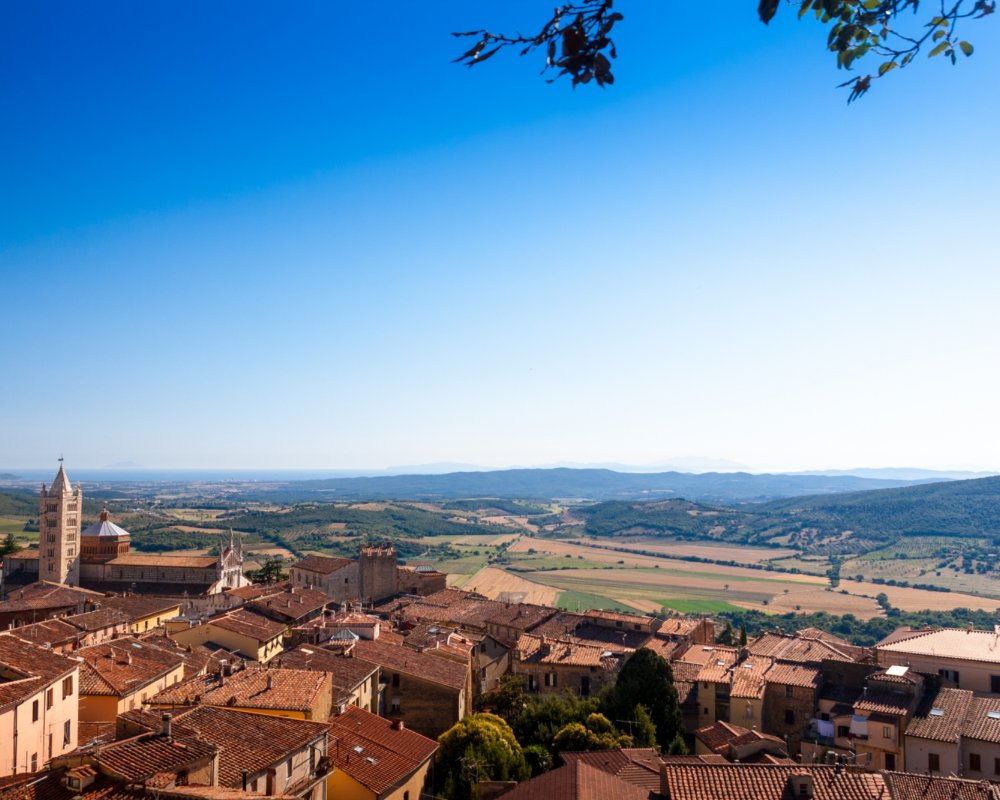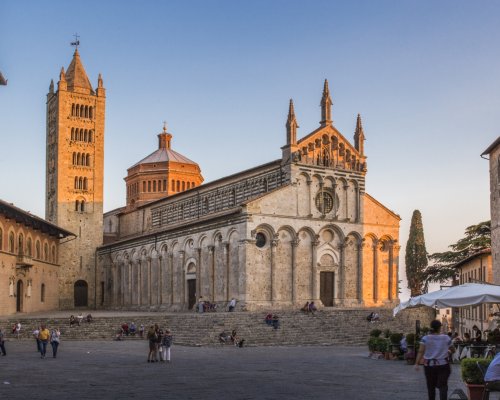Villages and landscapes in the Metalliferous Hills
It’s that corner of Tuscany, once Etruria, the land of the Etruscans, that even before the birth of Christ was home to a highly-evolved society, based on mining the resources that were hidden below the surface. Their primary peculiarity is made clear in the name: they’re the Metalliferous Hills, in Northern Maremma, a sea of wavy highlands situated where the provinces of Pisa, Siena and Grosseto meet.
Deep within them are an incredible variety of metals, from silver to copper, pyrite to zinc, making this area a mining and commercial centre since Antiquity. It was during the medieval area that so many small villages, dominated by towers and castles, began to pop up, many of which still dot the hills today. On these rolling, forest-covered slopes of cultivated land, mining was a resource used for developing the territory: this is how fortified towns safeguarding the copper and silver mines – which were used for minting coins – were founded, including Montieri, Monterotondo Marittima and the capital of the area, Massa Marittima.
Massa Marittima, gently stretched across a hill from which you can admire the final expansions of the Maremma, encloses behind its walls one of the most elegant architectural complexes in Tuscany. The city reached the height of prosperity in the 13th and 14th centuries, when it became a free commune and “silver fever” spread throughout the surrounding mines. Strolling around the historic centre you’ll can still breathe in the splendour of those days, especially in the wonderful piazza Garibaldi, which encircles the town hall, the Palazzo del Podestà and the Romanesque Cathedral of San Cerbone.
A walk in the Metalliferous Hills means giving yourself the chance to come face-to-face with history and the landscape. This is precisely what you will experience on the route between Massa Marittima and Lake Accesa, a small basin around which important ruins of Etruscan civilization were found.
Our journey begins in the medieval centre of Massa Marittima, as you look up to admire the warm colours of the palaces, looking for an idyllic glimpse of the surrounding hills. We begin in piazza Garibaldi, the heart of the town and home to the tall bell tower belonging to the Cathedral of San Cerbone. Next to it sit the most important buildings of worldly power: the Palazzo del Podestà, the Palazzo Civico and the former residence of the Biserno Counts. Take via Ettore Ximenes to arrive at Palazzo dell’Abbondanza, located next to the ancient and namesake fountain. On the wall that the water springs from, you can see the curious fresco celebrating masculine fertility, inspiring the name of the fountain (translated Fountain of Abundance).
Continuing up via Moncini, you’ll pass under the imposing Porta alle Silici, dominated from above by the Cassero Senese, a medieval fortified structure that protected the town in the Middle Ages, comprising a wall and defense towers. Head straight on for a few metres and, in piazza Matteotti, you’ll come to the Candeliere Tower, also known as the Clock Tower, built in the early 1200s and in an integral part of the town’s defense walls. Further on is the Palazzetto delle Armi, home of the Art and History of Mining Museum, while taking Corso Diaz will lead you to the Museum of Sacred Art, located in the complex of San Pietro all’Orto. The Church of Sant’Agostino and its cloister are nearby.
Our journey begins in the medieval centre of Massa Marittima, as you look up to admire the warm colours of the palaces, looking for an idyllic glimpse of the surrounding hills. We begin in piazza Garibaldi, the heart of the town and home to the tall bell tower belonging to the Cathedral of San Cerbone. Next to it sit the most important buildings of worldly power: the Palazzo del Podestà, the Palazzo Civico and the former residence of the Biserno Counts. Take via Ettore Ximenes to arrive at Palazzo dell’Abbondanza, located next to the ancient and namesake fountain. On the wall that the water springs from, you can see the curious fresco celebrating masculine fertility, inspiring the name of the fountain (translated Fountain of Abundance).
Continuing up via Moncini, you’ll pass under the imposing Porta alle Silici, dominated from above by the Cassero Senese, a medieval fortified structure that protected the town in the Middle Ages, comprising a wall and defense towers. Head straight on for a few metres and, in piazza Matteotti, you’ll come to the Candeliere Tower, also known as the Clock Tower, built in the early 1200s and in an integral part of the town’s defense walls. Further on is the Palazzetto delle Armi, home of the Art and History of Mining Museum, while taking Corso Diaz will lead you to the Museum of Sacred Art, located in the complex of San Pietro all’Orto. The Church of Sant’Agostino and its cloister are nearby.
From the museum complex of San Pietro all’Orto, leave the historic centre behind you as you head toward the Massa Marittima - Accesa municipal road and immerse yourself in the dense forest of oak trees. Walk along the ridges of the hills in the direction of the Montoccoli farm. Retracing the old road, continue toward Casa Fenice until you reach the historic mining village of Capanne Vecchia. This area, which developed in the first half of the 1800s around the Fenice Capanne mines, still shows the typical layout of mining villages, with the director’s villa in a dominant position over the small houses belonging to the miners. This place is a true treasure chest of mining archeology, embellished with structures that are still standing today, like the wooden headframe over the Carlo shaft and the depository for scraps from the Salerno shaft.
From the museum complex of San Pietro all’Orto, leave the historic centre behind you as you head toward the Massa Marittima - Accesa municipal road and immerse yourself in the dense forest of oak trees. Walk along the ridges of the hills in the direction of the Montoccoli farm. Retracing the old road, continue toward Casa Fenice until you reach the historic mining village of Capanne Vecchia. This area, which developed in the first half of the 1800s around the Fenice Capanne mines, still shows the typical layout of mining villages, with the director’s villa in a dominant position over the small houses belonging to the miners. This place is a true treasure chest of mining archeology, embellished with structures that are still standing today, like the wooden headframe over the Carlo shaft and the depository for scraps from the Salerno shaft.
Moving beyond Capanne, head back into the Mediterranean scrub along the dirt road leading to the area around Serrabottini, a historic mining site used as far back as the Etruscan era and even during the Middle Ages. Here, you can see the ruins of several mine shafts dating to the 14th and 15th centuries, when they were called bottini, which is where the town takes its name from. You’re now close to Lake Accesa, a legendary place located within a territory known for the high value of its nature. Four Etruscan villages were once situated along its banks, founded to make use of the copper mines. Today, the archeological artefacts coming from this site are housed in the Archeological Museum in Massa Marittima.
To bring your walk to a close, you can go back the way you came (24 km in total) or you can continue for 4.5 km on the provincial road to Valpiana, from where you can catch a bus back to Massa Marittima along the Follonica-Montieri line of Toscana Mobilità.
Moving beyond Capanne, head back into the Mediterranean scrub along the dirt road leading to the area around Serrabottini, a historic mining site used as far back as the Etruscan era and even during the Middle Ages. Here, you can see the ruins of several mine shafts dating to the 14th and 15th centuries, when they were called bottini, which is where the town takes its name from. You’re now close to Lake Accesa, a legendary place located within a territory known for the high value of its nature. Four Etruscan villages were once situated along its banks, founded to make use of the copper mines. Today, the archeological artefacts coming from this site are housed in the Archeological Museum in Massa Marittima.
To bring your walk to a close, you can go back the way you came (24 km in total) or you can continue for 4.5 km on the provincial road to Valpiana, from where you can catch a bus back to Massa Marittima along the Follonica-Montieri line of Toscana Mobilità.


